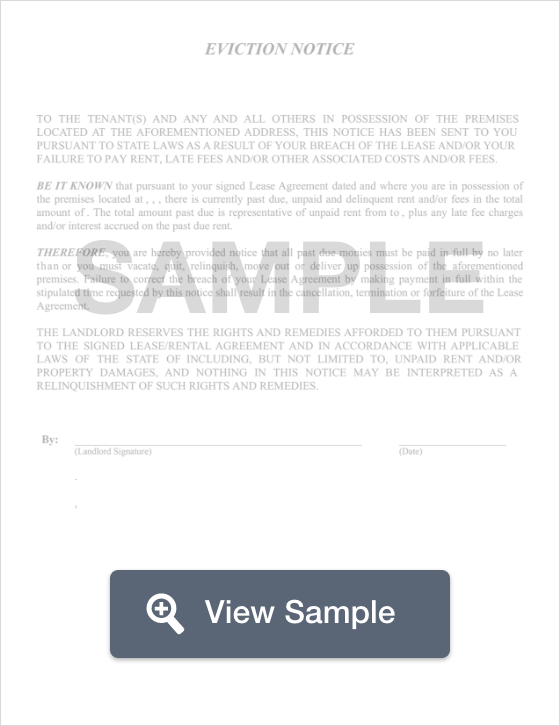What is an Eviction Notice?
An eviction notice, or Notice of Eviction, is a formal written statement from a landlord to a tenant that informs the tenant of one of two things:
-
The Tenant must vacate their rental property by a certain date; or
-
The Tenant must resolve an issue (or issues) by a certain date or vacate.
When do I need an eviction letter?
Without an eviction notice, you cannot legally begin the process of removing a tenant from your property. Pursuing an eviction without proper notice is illegal. It will likely put you, the landlord, on the hook for thousands of extra dollars in eviction-related costs, which include:
Damages incurred by the tenant:
-
Costs of temporary housing;
-
Moving costs;
-
Replacing damaged furniture and other belongings in the moving process;
-
Your tenant’s attorney fees to contest the unlawful eviction.
Fines & penalties:
-
Many states fine landlords for each day from the unlawful eviction until the legal resolution is determined.
-
Landlord legal fees.
-
In addition to covering the legal fees of your tenant, you’ll also have to pay for your attorney.
-
-
Additional costs.
-
A court may require you to compensate your tenant for the time missed from work to attend court.
-
You may also be held accountable for any damages caused by emotional and psychological pain/ or other damages associated with the eviction of your tenant.
-
You must always follow the law when it comes to evictions. A notice of eviction is the first, and, in many ways, the most important step in this process. Be sure that you not only issue an eviction notice, but you do so properly. Even the smallest technical error on a landlord’s part can provide a judge with legal grounds to dismiss the eviction complaint and force the landlord to restart the entire process.
How quickly can someone be evicted?
When you issue an eviction notice, you must provide the tenant with a time by which they need to vacate the premises or cure the defect that caused the issuance of the notice.
Normally, this ranges between 3 days and 60 days, depending on the reason for the eviction. (For example, in Connecticut, a landlord only needs to give a 3-day notice, but Georgia requires a 60-day notice).
You should consult your state law for this information or talk with a landlord-tenant attorney in the state where the property is located.
Are all evictions lawful?
No. Tenants have resources in many states that allow them to determine if they are being lawfully evicted. They have legal remedies they may pursue if they are the victim of illegal eviction.
Here are some common forms of unlawful evictions:
-
Retaliatory eviction. It is illegal for landlords to evict a tenant for reporting code violations to the building inspector or looking for other rentals.
-
No-Fault eviction. Again, this varies by city, but many cities require “cause” to evict a tenant before the end of their lease. If a tenant is being evicted without cause with time remaining on their lease, they may talk with a landlord-tenant attorney or research no-fault eviction laws to determine if they have a legal remedy they may pursue.
-
Excessive rent. A landlord cannot require a tenant to pay more than the amount of rent contractually owed.
-
Domestic violence. Again, this varies by state and sometimes by city, but a landlord generally may not evict victims of domestic violence solely on the basis that such incidents disrupt neighbors, cause excessive noise, etc.
-
Discrimination. It is unlawful for landlords to evict a tenant because of their race, gender, national origin, religious affiliation, sexual identity, family status, disability, marital status, veteran status, etc
-
Implied warranty of habitability. Landlords must provide tenants with a hospitable place to live that includes running water, heat (in cold areas) or air conditioning (in desert areas), etc. Much like a retaliatory eviction, tenants may not be evicted from the premises of the property that is uninhabitable and they report it as such.
How Can I Create An Eviction Notice?
FormSwift’s step by step builder makes it easy to create and send an eviction notice to your tenants.
Step 1: Tenant and State Information
When creating a Notice to Quit or Eviction Notice, it is important to have a copy of the lease agreement to ensure that all of the information provided in the notice is accurate. In this first step, you want to include the tenant’s title (Mr., Mrs., etc.), and his or her name. Under the tenant’s name, be sure to input their full address, including city, state, and zip code. Next, write the state laws that govern the property.
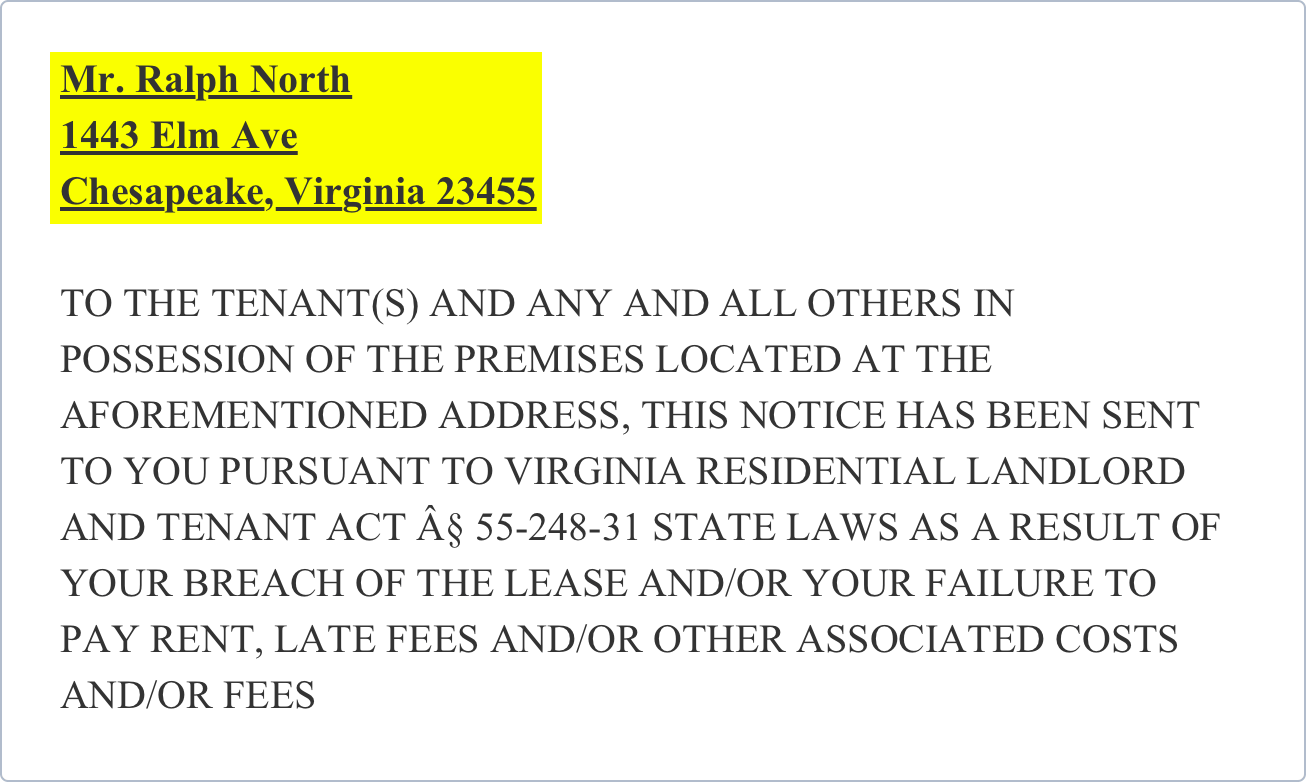
Step 2: Provide Notice and Dollar Amounts
Notify the tenant as to why they are being evicted and what must be done to remedy this issue. Be sure to provide the lease date and full address of the property that the tenant is currently residing in. Next, notify the tenant of the amount that is past due. This figure will be followed by the rental period that the rent is late, and the total amount due after pertinent fees.
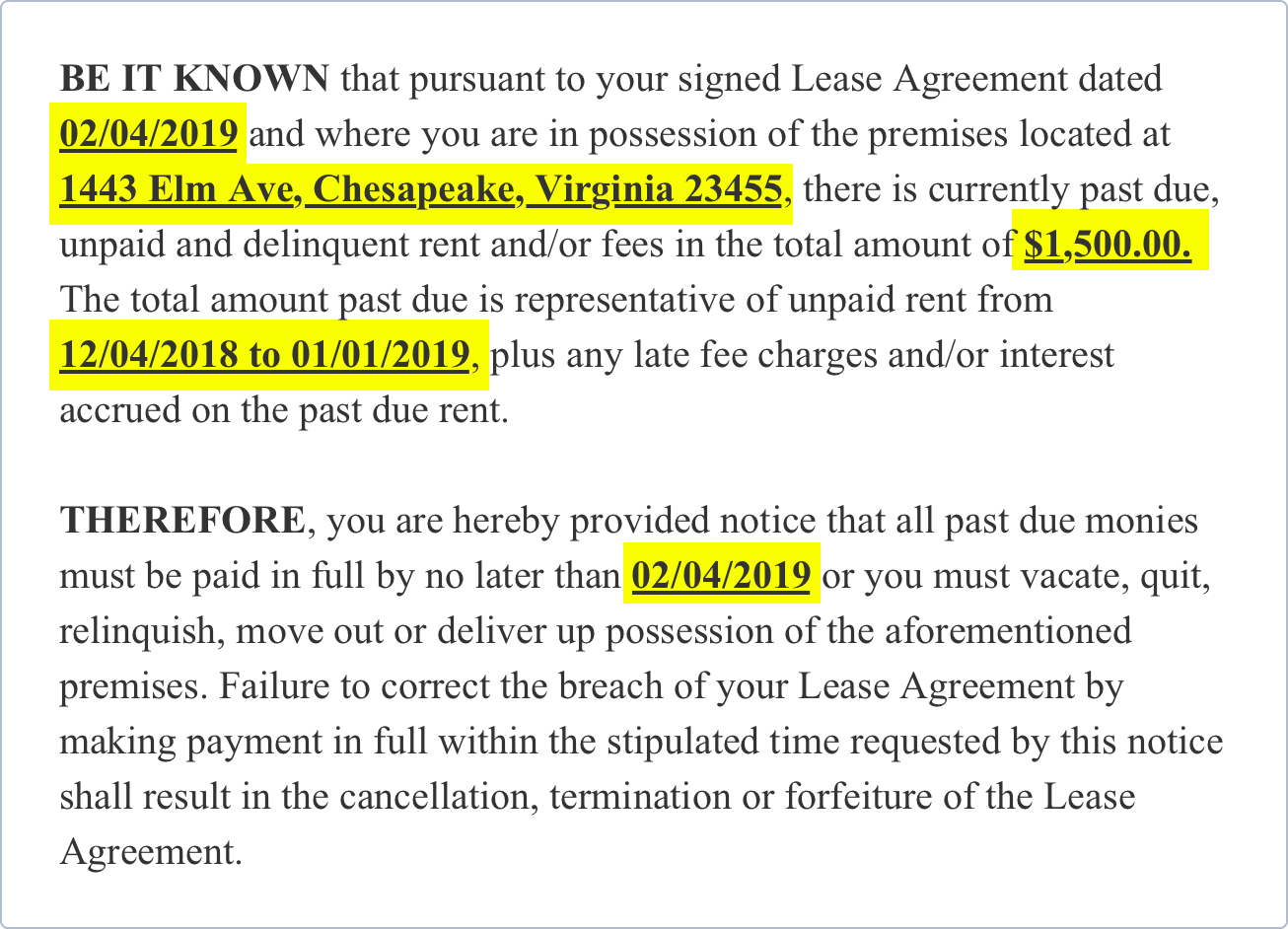
Step 3: Landlord Information and Signature
To finalize the notice, sign your name and date the form in the spaces provided. Underneath your signature, provide your full name, and address, including your city, state, and zip code. Next, provide your contact information (email address and phone number).
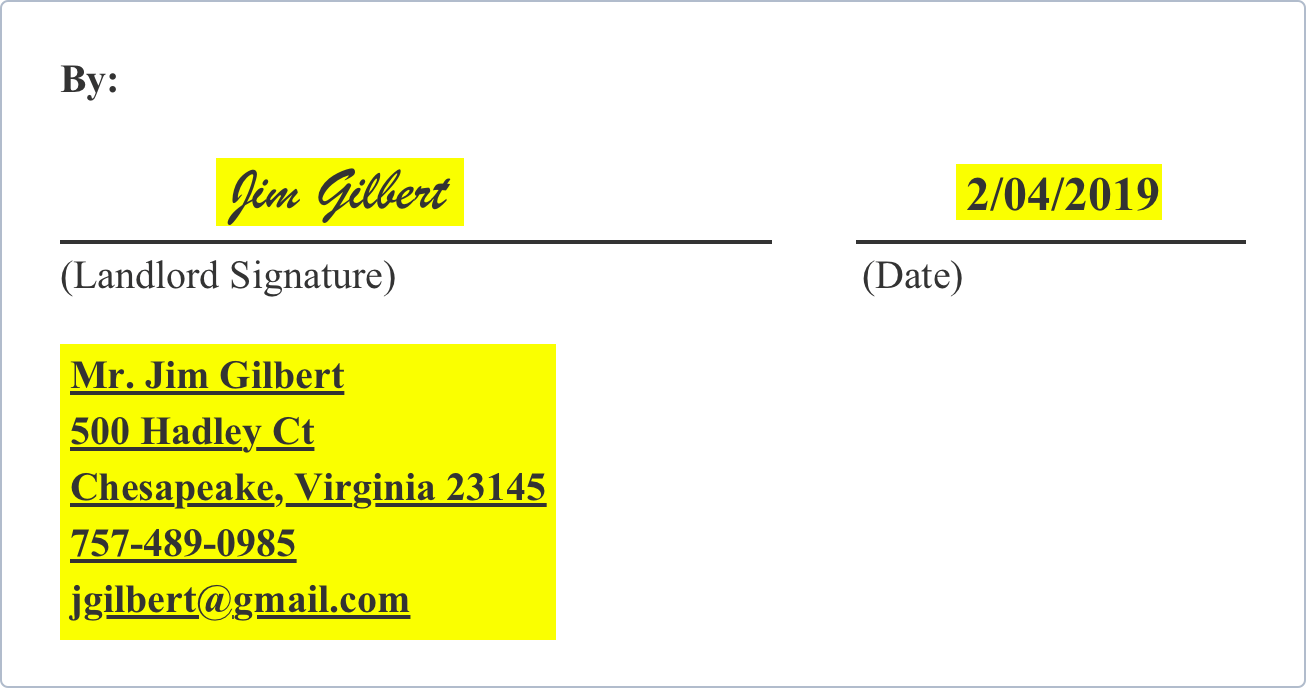
Step 4: Certificate of Service
For an Eviction Notice to be recognized by a court of law, it must be signed by the landlord and sent to the tenant in one of three recognized methods. A landlord must serve a tenant either in person, in-person to an individual who lives in the unit or via certified mail. When filling out the Certificate of Service portion of this form, be sure to state your name, the delivery method, and your signature, followed by your contact information.
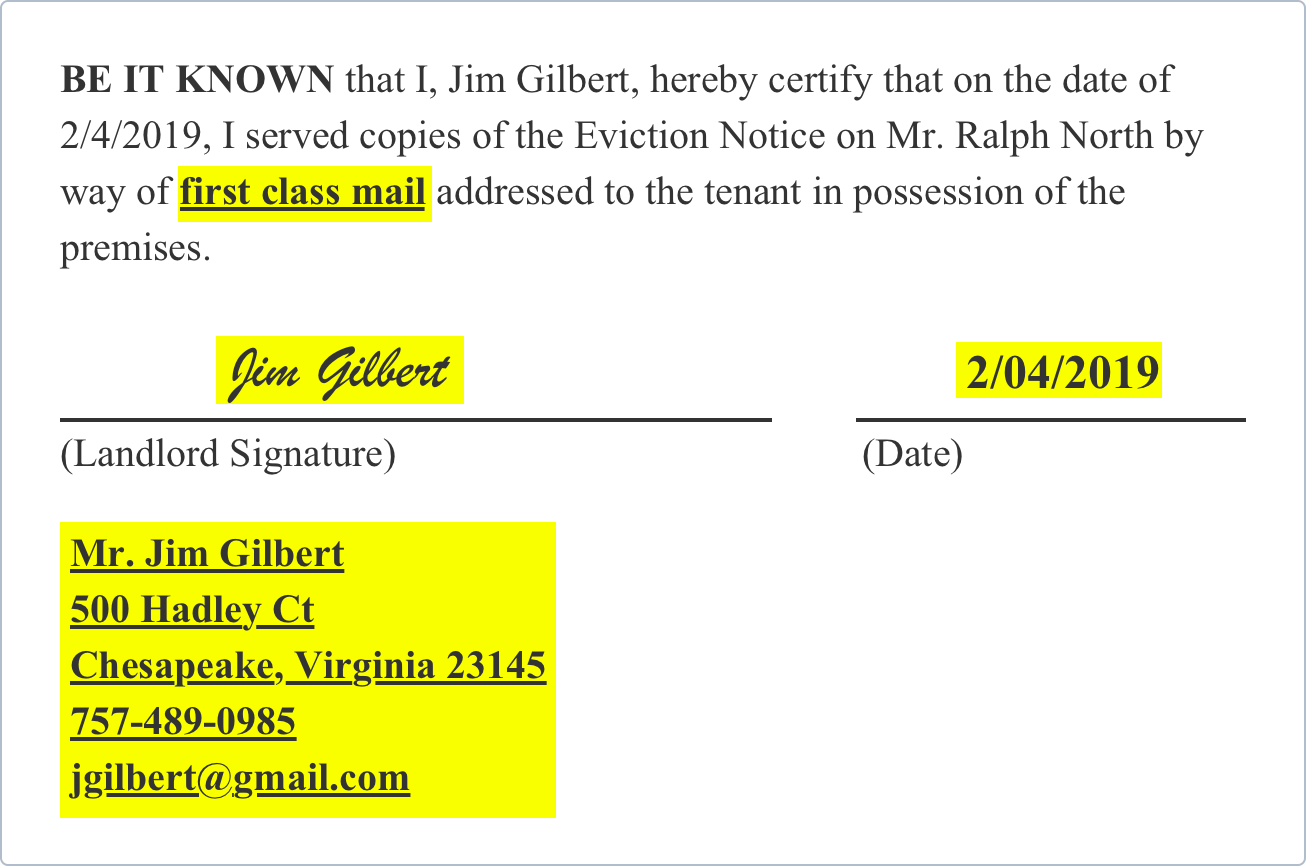
Legal Forms Related to an Eviction Notice
-
Lease Agreement: A legal document that sets out the terms by which a landlord will rent out a property to a tenant.
-
Rent Receipt: A document that confirms receipt of rent payments by a tenant.
-
Rental Application: A document that is used to gather information from prospective tenants applying to rent out the property.
Download a PDF or Word Template
Evicton Notice
An Eviction Notice is a tool for a landlord to comply with laws protecting tenants and which legally obliges a tenant to vacate the landlord's premises.
 Read More
Read More
Quit Claim Deed
Quit claim deeds legally entitle someone to transfer their interests, as opposed to ownership, in any specified real estate.
 Read More
Read More
Lease Agreement
A signed lease agreement establishes legally enforceable rights and duties of two parties who enter into an arrangement for borrowing or using of specified property. It covers term of lease, fees, details of the parties and property inventory and condition.
 Read More
Read More
Special Power of Attorney
A Special Power of Attorney document sets out the wishes and directions for one or more 'Agents', 'Attorneys-in-fact' or 'Attorneys' to take decisions on behalf of a named 'Principal'. It can cover a range of specified conditions in which the Attorney is authorized to act on behalf of the Principal.
 Read More
Read More
